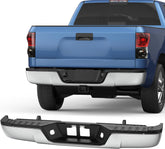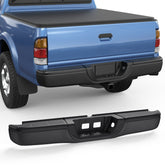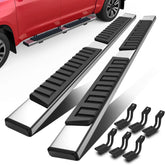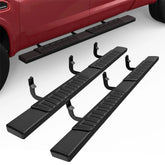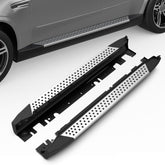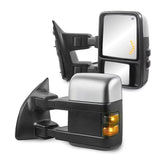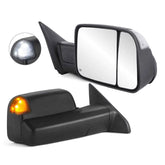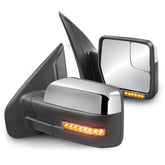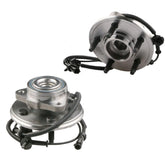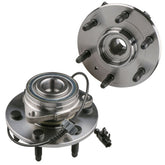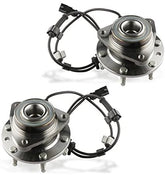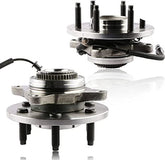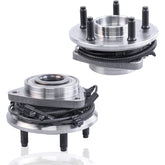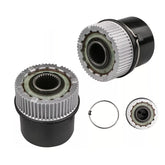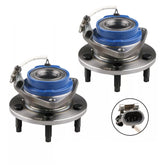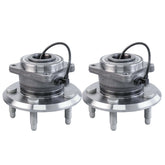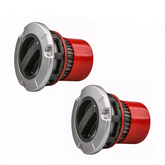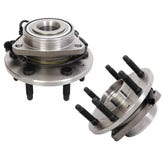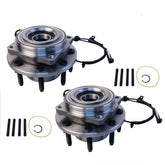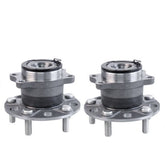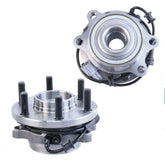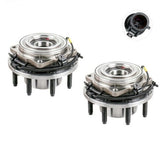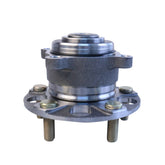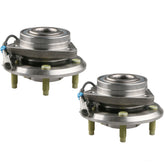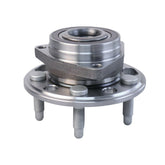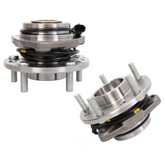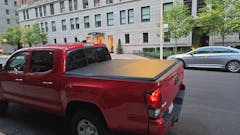Filter
55 results
20
- 10
- 15
- 20
- 25
- 30
- 50
Best selling
- Featured
- Best selling
- Alphabetically, A-Z
- Alphabetically, Z-A
- Price, low to high
- Price, high to low
- Date, old to new
- Date, new to old
Sort
Sort by:
- Featured
- Best selling
- Alphabetically, A-Z
- Alphabetically, Z-A
- Price, low to high
- Price, high to low
- Date, old to new
- Date, new to old
-
MOSTPLUS 2x Front Complete Wheel Hub Bearing Assembly with ABS For Ford Explorer 515050Vendor: MOSTPLUSThe third-generation hub bearing unit with ABS sensor. The hub unit includes an inner flange and an outer flange. The inner flange is bolted to the rim (steel ring). The outer flange and the outer ring of the bearing are integrated and installed in...
- $95.99
- $95.99
- Unit price
- / per
-
2x Front Wheel Hub Bearing Fit For GMC Yukon Chevy Tahoe Cadillac Escalade 515096Vendor: MOSTPLUSThe hub unit includes an inner flange and an outer flange. The inner flange is bolted to the rim (steel ring). The outer flange and the outer ring of the bearing are integrated and installed in the steering Section.MOSTPLUS wheel hub assembly has a...
- $119.99
- $119.99
- Unit price
- / per
-
Front Wheel Hub Bearing Fit For GMC Chevy Truck 2WD 515053 515071 Pair (2)Vendor: MOSTPLUSThe third-generation hub bearing unit with ABS sensor. The hub unit includes an inner flange and an outer flange. The inner flange is bolted to the rim (steel ring). The outer flange and the outer ring of the bearing are integrated and installed in...
- $104.89
- $104.89
- Unit price
- / per
-
2x Front Wheel Hub Bearing Fit For 2002-2009 Chevy Trailblazer GMC SUV w/ ABS 6 Lug 513188Vendor: MOSTPLUSThe third-generation hub bearing unit with ABS sensor. The hub unit includes an inner flange and an outer flange. The inner flange is bolted to the rim (steel ring). The outer flange and the outer ring of the bearing are integrated and installed in...
- $95.58
- $95.58
- Unit price
- / per
-
2x Front Wheel Hub Bearing Fit For 2005-2008 Ford F-150 w/ ABS 6 Lug 515079Vendor: MOSTPLUSThe hub unit includes an inner flange and an outer flange. The inner flange is bolted to the rim (steel ring). The outer flange and the outer ring of the bearing are integrated and installed in the steering Section.MOSTPLUS wheel hub assembly has a...
- $139.99
- $139.99
- Unit price
- / per
-
2x Front Wheel Hub Bearing Fit For Chevy GMC w/ ABS 6 Lug Only For 4WD 515036Vendor: MOSTPLUSThe hub unit includes an inner flange and an outer flange. The inner flange is bolted to the rim (steel ring). The outer flange and the outer ring of the bearing are integrated and installed in the steering Section.MOSTPLUS wheel hub assembly has a...
- $105.99
- $105.99
- Unit price
- / per
-
Pair Front Wheel Hub Bearing Assembly For 2008-2012 Jeep Liberty 07-11 Dodge Nitro 513270Vendor: MOSTPLUSBuilt by Superior Material, Polished and Anti-rusted Surface for longer usage. Unique Sealing Design keeps hub clean, reduce vibration and noise.Details: Brand: MOSTPLUS Warranty: 1 Year Lug: 5 Lug Wheel OE Part Number: 513270, 590245, 930697 Technical Information 5 Lugs; Round ABS connector; Flange...
- $102.72
- $102.72
- Unit price
- / per
-
Front Auto Locking Hubs For 1999-2003 Ford F250 F350 F450 2000-2005 Excursion 4WD (Set of 2)Vendor: MOSTPLUSDetails: Brand: MOSTPLUS Warranty: 1 Year Drive Type: 4WD Replacement OEM Number: 600-203, 1C3Z3B396CB Place on Vehicle: Front Left (Driver) Side and Right (Passenger) Side Fitment: 2000-2005 Ford Excursion Driver or Passenger Side 1999-2004 Ford F250 Super Duty Truck Driver or Passenger Side 1999-2004...
- $79.99
- $79.99
- Unit price
- / per
-
Front Wheel Hub and Bearing Assembly for Chevy Pontiac With ABS 5 Lug 513121X2 (Set of 2)Vendor: MOSTPLUSThe hub unit includes an inner flange and an outer flange. The inner flange is bolted to the rim (steel ring). The outer flange and the outer ring of the bearing are integrated and installed in the steering Section.MOSTPLUS wheel hub assembly has a...
- $91.50
- $91.50
- Unit price
- / per
-
Rear Left & Right Wheel Hub Bearing For 2010-2017 Chevy Equinox GMC Terrain 512440Vendor: MOSTPLUSBuilt by Superior Material, Polished and Anti-rusted Surface for longer usage. Unique Sealing Design keeps hub clean, reduce vibration and noise.Details: Brand: MOSTPLUS Warranty: 1 Year Lugs: 5 Bolt OE Part Number: 512440,WE60837 Position: Left, Right, Rear Technical Information 5 Lugs; Round ABS connector;...
- $98.87
- $98.87
- Unit price
- / per
-
Front Manual Locking Hub For 2005-2016 Ford F250 F350 F450 F550 Super Duty 4WD (Set of 2)Vendor: MOSTPLUSDetails: Brand: MOSTPLUS Warranty: 1 Year Fits LH (Driver Side) OR RH (Passenger Side) Fits 4WD (Four Wheel Drive) Models with Manual Locking Hubs only Fitment Type: Direct Replacement Replacement OEM Number: BC3Z-3B396-B Fitment: 2005-2016 Ford F-250 Super Duty 2005-2016 Ford F-350 Super Duty...
- $79.99
- $79.99
- Unit price
- / per
-
Front Wheel Hub Bearings Assembly For 2007-2013 Silverado Sierra 1500 4WD 515160 (Set of 2)Vendor: MOSTPLUSDetails: Brand: MOSTPLUS Warranty: 1 Year Lugs: 6 Bolt Driver Type: 4WD ABS Type: Sensor Wire Flange Type: 3-Bolt Triangular Placement on Vehicle: Left, Right, Front Fitment: MAKE MODEL YEAR RANGE SPECIFIC DETAILS CADILLAC ESCALADE 2007 - 2014 AWD CADILLAC ESCALADE ESV 2007...
- $109.99
- $109.99
- Unit price
- / per
-
2x Front Wheel Hub Bearing Assembly For 2011-2016 Ford F-350 F-250 Super DutyVendor: MOSTPLUSThe hub unit includes an inner flange and an outer flange. The inner flange is bolted to the rim (steel ring). The outer flange and the outer ring of the bearing are integrated and installed in the steering Section.MOSTPLUS wheel hub assembly has a...
- $258.90
- $258.90
- Unit price
- / per
-
2x Rear Wheel Bearing Hub Assembly For Jeep Compass Patriot Dodge Caliber 512333Vendor: MOSTPLUSThe hub unit includes an inner flange and an outer flange. The inner flange is bolted to the rim (steel ring). The outer flange and the outer ring of the bearing are integrated and installed in the steering Section.MOSTPLUS wheel hub assembly has a...
- $85.99
- $85.99
- Unit price
- / per
-
2x Front Wheel Hub Bearings For Nissan Frontier Pathfinder Suzuki Equator 515065Vendor: MOSTPLUSThe hub unit includes an inner flange and an outer flange. The inner flange is bolted to the rim (steel ring). The outer flange and the outer ring of the bearing are integrated and installed in the steering Section.MOSTPLUS wheel hub assembly has a...
- $109.52
- $109.52
- Unit price
- / per
-
2x Front Wheel Hub Bearing Fit For 05-10 Ford F250/F350 Super Duty 4WD 515081Vendor: MOSTPLUSThe hub unit includes an inner flange and an outer flange. The inner flange is bolted to the rim (steel ring). The outer flange and the outer ring of the bearing are integrated and installed in the steering Section.MOSTPLUS wheel hub assembly has a...
- $237.99
- $237.99
- Unit price
- / per
-
Rear Wheel Hub Bearing Assembly For 2008-2012 Honda Accord 2009-2013 Acura TSX 512353Vendor: MOSTPLUSThe hub unit includes an inner flange and an outer flange. The inner flange is bolted to the rim (steel ring). The outer flange and the outer ring of the bearing are integrated and installed in the steering Section.MOSTPLUS wheel hub assembly has a...
- $48.56
- $48.56
- Unit price
- / per
-
2X Front Wheel Hub Bearing Assembly 513276 For Chevy Equinox Pontiac Saturn Vue SuzukiVendor: MOSTPLUSThe hub unit includes an inner flange and an outer flange. The inner flange is bolted to the rim (steel ring). The outer flange and the outer ring of the bearing are integrated and installed in the steering Section.MOSTPLUS wheel hub assembly has a...
- $86.99
- $86.99
- Unit price
- / per
-
Front Rear Wheel Bearing Hub For Chevy Equinox Buick LaCrosse Cadillac XTS CTS 513288Vendor: MOSTPLUSThe hub unit includes an inner flange and an outer flange. The inner flange is bolted to the rim (steel ring). The outer flange and the outer ring of the bearing are integrated and installed in the steering Section.MOSTPLUS wheel hub assembly has a...
- $59.29
- $59.29
- Unit price
- / per
-
Pair Front Wheel Hub Bearings For Chevy Blazer S10 GMC Sonoma 1997-2005 JimmyVendor: MOSTPLUSDetails Brand: MOSTPLUS Warranty: 1 Year Bolt Size: M12*1.5 Bolt Pattern: 5 x 4.75 in. Hub Pilot Diameter: 3.62 in. / 91.9 mm Bolt Circle Diameter: 4.75 in. / 120.6 mm Flange Diameter: 5.73 in. / 145.5 mm Flange Offset: 1.85 in. / 47...
- $85.99
- $85.99
- Unit price
- / per
